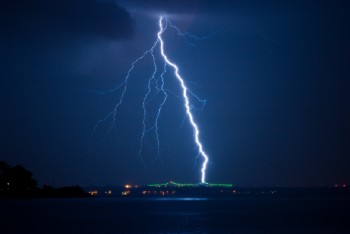By Allison Brown, Canadian Red Cross Digital Volunteer
You may have heard the saying “when thunder roars, head indoors”, and that’s great advice. Thunderstorms move quickly, and may be accompanied by high winds, heavy rain, hail, or
tornadoes. Pay attention to weather warnings.
When outdoors, keep checking for rapidly darkening skies or increasing wind, and seek shelter immediately if you hear thunder or see lightning. If you can't get home or into shelter, here are some things to keep in mind:
Negative charges in storm clouds are attracted to positive charges around anything that is taller than the surrounding area. Lightning will also strike the ground.
- Avoid sheltering under trees or near telephone poles.
- In open areas like fields, crouch low to the ground but don't lie down flat.
- If you cannot shelter indoors, another shelter option is a vehicle. It's always a good idea to have an emergency kit in your car.
There's a reason why lightning rods are made of metals like copper: metals are excellent conductors of electricity that attract lightning's zap.
- Stay away from metal objects like chain link fences and metal sheds
Water also conducts electricity, so:

- Get out of a lake or pool immediately if you hear thunder.
- If you are in a boat, get to shore as quickly as possible
- Avoid any water during a thunder and lightning storm
- Be careful around creeks and rivers – flash flooding could occur.
Thunderstorms can be associated with heavy rain and high winds, which can reduce visibility on our roads. If driving, pull over safely and park your vehicle with the emergency (hazard) lights flashing until the heavy rain subsides.
Don't drive through flooded areas - the water can be much deeper than it appears! Remember: Turn Around, Don't Drown!
Even if you're safely sheltered indoors, there are still thunderstorm- related dangers to keep in mind:
- Do not use electrical equipment or plumbing (remember, water and metal conduct electricity) - that shower can wait until after the shower outside’s done.
- Be prepared for power outages that can be of long duration. You'll be glad you prepared your emergency kit with three days worth of supplies.
Thunder and lightning are impressive displays - lightning is hotter than the surface of the sun, and thunder is caused by air rapidly expanding when exposed to lightning's heat. You'll enjoy the show a lot more from the comfort of your home - pull up a chair and watch what all those thunderstruck musicians have been singing about, well back from your windows!
If someone is struck by lightning, call 911 for medical assistance. Check the area for dangers such as live wires, then administer first aid if trained. The
Canadian Red Cross First Aid app has helpful information, and you can also find a
first aid course to attend in your area.